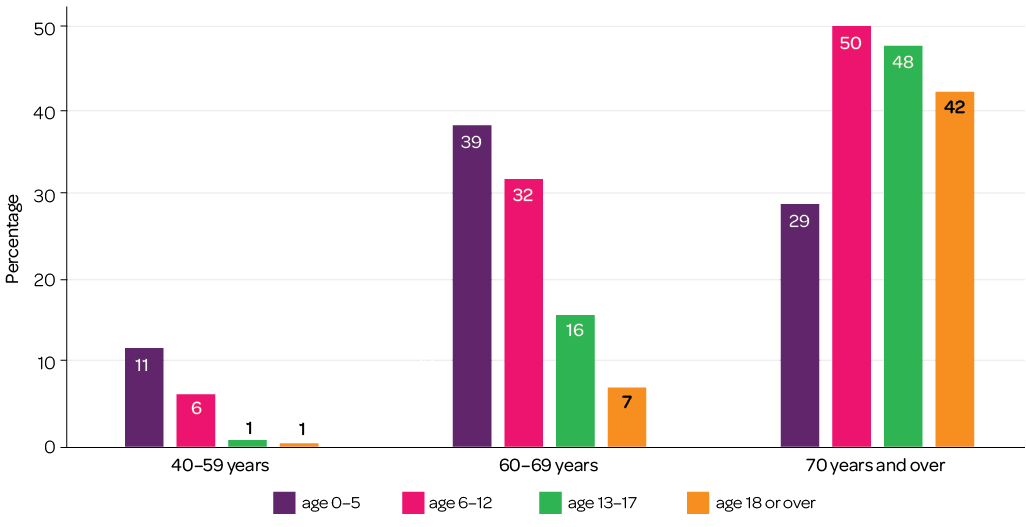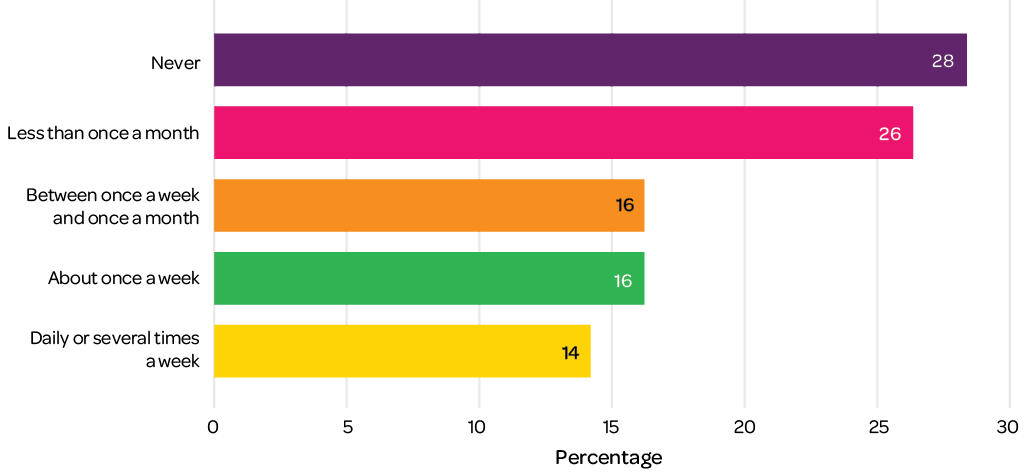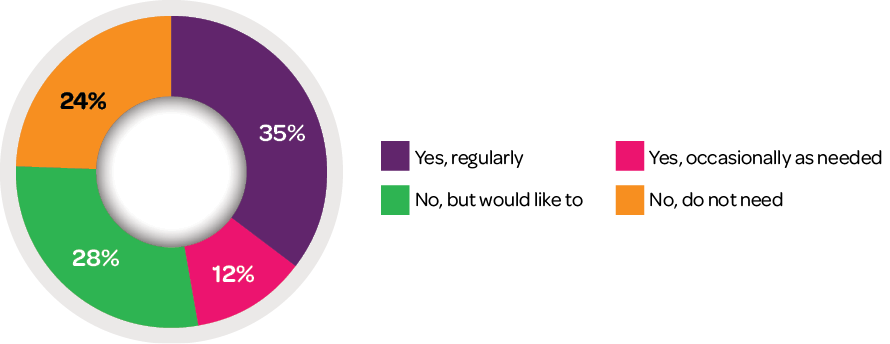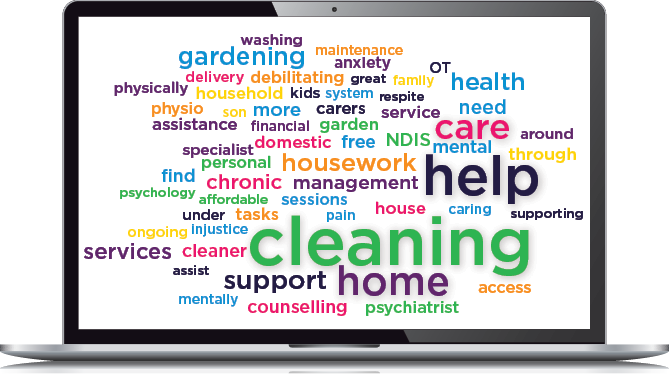Towards COVID normal: Connection to family, friends and community
Families in Australia Survey report
May 2021
Megan Carroll, Mikayla Budinski, Diana Warren, Jennifer Baxter, Jacqui Harvey
Download Research report
Overview
Towards COVID Normal, the second survey in the AIFS Families in Australia Survey series, ran from 19 November to 23 December 2020, when restrictions were no longer in place in most parts of Australia.
In the first survey, we focused on how families adjusted to the pandemic and the restrictions that were in place: how they experienced the social and economic impacts of the pandemic, how they supported each other, and how they protected their physical and mental health.1 The second survey focused on how families were adjusting to 'COVID normal'.
The findings in this report are drawn from our first analyses of data from our second survey, building on our findings from the first survey. We looked at connection with others - from family members living elsewhere to the local community. Later reports will add to and expand on these findings.
1 See the reference list for some of our publications from the first survey Life during Covid-19
Key messages
-
Barriers to connection: Limited technological skills was a common barrier to older people connecting with family, although several older participants commented that adult children were too busy or unwilling to communicate.
-
Grandparents: Many grandparents found their regular patterns of care of or contact with grandchildren disrupted by COVID restrictions and felt disconnected and isolated from their children and grandchildren. 14% of respondents with grandchildren aged under 13 years provide child care daily or several times a week and another 16% provide child care about once a week.
-
Help and support: almost 30% of respondents who reported needing help with everyday tasks due to a disability or illness said that they did not receive help from professional services but they would like to.
'I would like access to ongoing psychology or counselling sessions to support my son as he faces the challenges of life with ADHD through adolescence and beyond.'
Female, aged 37 -
Volunteering: COVID prevented many people from performing volunteer work. The number of respondents volunteering since COVID restrictions were lifted has not equalled the numbers volunteering before restrictions, suggesting that volunteer numbers across Australia have yet to recover to pre-COVID levels.
Connection to family
The effect of distance
In the early stages of the pandemic, we looked at the ways that people stayed connected with each other when they were forced to be apart, and found that time, distance and technology were the main barriers (see Life during COVID-19: Report no. 2). Here, we focus on connections to family members living elsewhere.
People with family members who live nearby are likely to have shorter but more frequent visits with those family members, which can result in more quality time and stronger familial bonds. Furthermore, if those close family members can help with everyday activities or child care, or are available in case of an emergency, it can provide a sense of security and peace of mind.
Besides the family they live with, 58% of our survey respondents said they had family members living within 30 minutes of home. However, with 30% of Australians born overseas and over 400,000 moving interstate each year (ABS, 2020a), long-distance family is a common thing. It was fairly rare for people to report having no family living in the same state but many reported having at least some relatives living interstate or overseas (see Figure 1).
Figure 1: Distance from family members not living in the same household

Among those with family living interstate or overseas, there were slightly higher rates of feeling either 'very little connection' or 'not at all connected' to family (29%), compared to those with family two hours or less away (18%). But even among those with family living further away, the most common response (47%) to the question of connection was feeling moderately connected to family.
Feelings about contact with family
Contact and communication between family members shifts and changes over time and depends on many factors, including the age of family members, the culture in which they live, their gender, their stage of life (e.g. whether they have children or grandchildren) and how well they get along with each other.
Half (49%) of respondents felt the amount of contact they had with their families was about right. The next most common response (30%) was 'too little'. Very few people (only about one in 100) felt they had too much contact with family living elsewhere (Figure 2).
Figure 2: Amount of contact with family members, by distance from closest family member living elsewhere

Among respondents with family living elsewhere in Australia, the proportion who felt the amount of contact they had with family members living elsewhere was either 'too little' or 'far too little' increased with distance from their nearest family.
Interestingly, people whose nearest family lived overseas were more satisfied with the amount of contact they had than those with family living interstate. This difference may reflect expectations about the amount of contact we have with families living overseas, as well as the impact of COVID restrictions on interstate travel.
Barriers to contact
People who felt they had too little contact with family living elsewhere were asked whether there was anything that could improve the amount of contact they had with family. 'More free time' (50%), 'less COVID restrictions' (46%) and 'improved relationships with their families' (23%) were the most common responses. Around one in six (16%) said improved technology or technological skills would be helpful.2

Other responses often focused on issues related to distance, such as negotiating conversations across time zones, or the cost and availability of flights (both interstate and overseas), as well as local transport barriers for families who don't drive or have poor public transport connections. Limited technological skills or use by older family members was also a common concern, although several older participants also commented that adult children were too busy or unwilling to communicate.
'It is impossible to explain why Zoom is not working over Zoom! It would be good if there was someone in their small town who could help them.'
Female, aged 34
'Sons getting off their backside to visit.'
Female, aged 59
'Being low income slightly higher payments would mean I could afford to travel to see family.'
Female, aged 34
'Lower fuel/transport costs … or hey? Give us country people ACTUAL public transport.'
Female, aged 36
'My age means I don't drive longer distances as much.'
Female, aged 79
2 The true figure is likely to be higher, however, as the Families in Australia Survey is an online survey and is unlikely to have captured many families for whom access to technology is a true barrier.
Caring during COVID
Grandparents and grandchildren
The help and support that we provide each other as family members is important. The first survey showed that there was a heightened need for this care and support during the pandemic, with some families experiencing major changes in the arrangements they had in place for caring for children and for family members who required assistance due to disability or illness (see Life during COVID-19: Report no. 3).
Grandparent care was impacted by the pandemic. In the first survey, nearly three out of 10 grandparents told us they provided child care at least weekly before COVID-19, and most told us that during COVID-19 they ceased providing care (see Life during COVID-19: Report no. 1).
For family at opposite ends of the age spectrum, the grandparent-grandchild relationship can be among the most important.
Eighty per cent of those aged 70 years and over said that they had grandchildren, with percentages lowering with age: 53% at 60-69 years; 24% at 50-59 years; and 5% at 40-49 years. The 60-69 year olds were most likely to be grandparents to 0-5 year olds (39%), while - hardly surprisingly - people aged 70 years and over were more likely to have older grandchildren (Figure 3).
Figure 3: Percentage reporting to have grandchildren in different age groups

Caring for grandchildren
For many families, grandparents are important and highly valued providers of child care. Among grandparents with grandchildren aged up to 13 years, almost half provide some child care at least once a month, including 14% providing care daily or several times a week and 16% providing care about once a week (Figure 4). Grandparents were providing care to children across a range of ages, with 14% reporting caring for a grandchild less than one year old, and 22% caring for grandchildren aged six or older.
Figure 4: Frequency of providing care to grandchildren

How the pandemic affected grandparenting
Grandparents' contact with and care of their grandchildren was disrupted in 2020 because of COVID restrictions and parents' work changes (e.g. increased working from home). Some of these issues emerged when we asked grandparents to comment about their contact with grandchildren and impacts of COVID. Key family-related impacts they described were:
- having their regular patterns of care of or contact with grandchildren disrupted by COVID-related restrictions
- feeling disconnected and isolated from their children and grandchildren
- missing out on family traditions.
While some grandparents reported that not much had changed for them, others reported that missing out on regular family supports had exacerbated mental and physical health issues for themselves and/or their adult children. Still others - for instance those whose children were essential workers - reported that they had taken on extra child care responsibilities.
Some grandparents noted that during COVID they had experienced disconnects from their wider community: for example, being unable to participate in voluntary work in the local school (see also 'Community and volunteering' below).
The ability to maintain connection to family via technology was two-sided: while some grandparents were grateful for technological solutions to the connection dilemma, others found them frustrating.

'I have been thankful for Zoom so that I can keep in touch with my grandchildren and two great grandchildren.'
Female, aged 74
'She was only 8-months old when I last saw her and now I haven't seen my granddaughter since February 2020. I used to see her every fortnight.'
Female, aged 60
'Because of COVID I have only been able to hold our grandchildren once in the last six months. All other contact has been by video calls. Before that I would see the grandchildren at least once a month and often more.'
Male, aged 61
'As both parents kept working through the pandemic, I continued to pick my grandson up from school almost every day. One parent is an essential worker and one is a tradesman. The tradesman became very busy during the pandemic.'
Female, aged 72
Caring for household members
Just over one in 10 survey respondents (11%) said that someone else in their household needed help with everyday tasks due to disability or illness.
Among those who provided care or assistance for a household member, most (94%) did so for only one household member. Of those who said that someone in the household needed help with everyday tasks:
- 71% provided care or assistance for a spouse or partner
- 54% provided care or assistance for a child
- 11% provided care or assistance for a parent
- 6% did not provide any care or assistance.
Around one in six (16%) respondents who said they needed assistance due to a disability or illness were themselves caring for someone else in their household.
For many people who were caring for a household member with an illness or disability, 2020 presented new challenges. The pandemic forced changes to the availability of in-home support services, stoked fears for how COVID-19 might affect family members (both physically and mentally), and added additional pressures due to working from home and remote learning.
Compared to those who were providing assistance to a spouse, partner or parent, respondents who were caring for a child spent more hours per week providing assistance (43% spent at least 30 hours per week, compared to 32% for those caring for a parent and 26% for those caring for a partner).
Among those who provided care or assistance, the majority (70%) said that the amount of hours they spent on caring activities had increased in 2020; 27% said it had not changed, and only 3% said the hours they spent caring had decreased.
Among those who said the hours they spent doing caring activities had increased during 2020, around 40% were spending more than 30 hours per week doing caring activities (20% were spending more than 60 hours).
'My mum has dementia and it has deteriorated this year so she needs more assistance however I also live with my sister and so we share the caring duties and my mum also has community nurses who come in during the week. Mum had a fall right at the beginning of lockdown so was in hospital and then rehab for the whole of the lockdown period. This was very confusing for
Female, aged 53
'My wife is working from home and as such less active which adversely impacts her. Also being at home all the time I need to help her more. As she is high risk of getting COVID-19 and higher risk if she did get it I needed to do all the shopping.'
Male, aged 58
'My daughter has ASD and ADHD and is constantly with me wanting my support. Normally I receive respite through a number of activities she is involved with and support from grandparents, but due to COVID we haven't received these supports this year.'
Female, aged 42
Caring for family and friends living elsewhere
Many Australians provide support or assistance to family and friends living elsewhere. In 2019, over half (52%) of the Australian population aged 15 years and over provided unpaid support to non-household members, with emotional support, assistance with transport or errands and help with domestic work, home maintenance or gardening the most common types of support provided (ABS, 2020b).
The first survey explored the types of help and support that family members provided each other during restrictions, and found that the pandemic impacted people's ability to help, and caused many people who needed help to struggle to get it (see Life during COVID-19: Report no. 3).
In the second survey, when restrictions had eased in most areas, four out of five respondents said they had helped someone living outside their household in the past month. The most common type of help provided was emotional support (67%), followed by shopping or provision of food supplies (35%) and providing transport or running errands (31%).
Around one in five had helped someone outside their household with domestic work, home maintenance or gardening. A similar proportion (19%) had provided financial support.
The types of support provided differed depending on who was being helped:
- Respondents helped friends and work colleagues with emotional support more than other types of support.
- Practical support and financial support was mainly provided by relatives; many also turned to their relatives for emotional support.

Help with everyday tasks
One in 20 respondents (5%) said they needed help with everyday tasks due to a disability or illness. Not surprisingly, the percentage who needed help was higher among older respondents (13% for those aged 70-79 and 28% for those aged 80 or older, compared to 3-6% for younger age groups).
Among those who needed help, 35% said they regularly received assistance from a professional service, 12% said they received care or assistance from a professional service occasionally, as needed, and almost 30% said that they did not receive help from professional services but they would like to (Figure 5).
Figure 5: Use of care or assistance from a professional service

The types of professional services used included physical and mental health services, as well as home help such as cleaning and gardening.
The types of services respondents said they needed but could not get were similar to the types of services used by those who had accessed professional services:
Figure 6: Word map - Used professional services

Figure 7: Word map - Did not use professional services, but would like to

'We currently access a psychiatrist and psychologist through the private system which places a huge strain on the family financially. We recently attempted to access public support through headspace but were advised that the waiting list would be extremely long and that the program was probably not suited to our family given the assumption that our son would require ongoing support and not just 10 sessions under a mental health care plan. I would like access to ongoing psychology or counselling
Female, aged 37
Among those who accessed professional services, either regularly or occasionally, 28% said access to these services had decreased in 2020, 30% said access had increased and 31% said it had stayed the same. Whether access to services had increased, decreased or stayed the same in 2020 did not vary by the types of services used.
Community and volunteering
Australia has a strong culture of community volunteering - almost 30% of Australians aged 15 years and over participated in unpaid voluntary work through an organisation in 2019 (ABS, 2020b). Volunteering has been shown to have a variety of benefits, including higher levels of life satisfaction, learning new things and building positive connections within the community.
The pandemic meant that how Australians volunteered changed in 2020, with a substantial workforce gap in many volunteer-reliant charities, older volunteers restricted in the types of volunteer work they could do and, at the same time, demand for services from charities increasing due to the impact of COVID on employment and income.
The percentage of respondents or their partners who had engaged in volunteer work in 2020 increased with age. Over a quarter (27%) of respondents or their partners engaged in some form of voluntary work in the past year, including half of those aged 70-79, 36% of those living alone, and 40% of those living in remote areas.3
The number of people volunteering since COVID restrictions were lifted has not equalled the numbers volunteering before restrictions, suggesting that volunteer numbers across Australia have yet to recover to pre-COVID levels (Figure 8).
Figure 8: Participation in volunteer activities, by age group

Note: Based on information provided by respondents about their own volunteering activities, and those of their spouse or partner (if they have one).
Of those who volunteered at some time during 2020, almost two in three (62%) continued to volunteer throughout the year, 20% volunteered before COVID and have yet to return to volunteering, 6% started volunteering after COVID, 4% stopped volunteering during COVID but have returned to volunteering, and 4% volunteered only during COVID (the remaining 5% is other combinations).
Open-text responses showed that COVID-19 affected volunteering activities in a variety of ways. For some in a high-risk category, face-to-face volunteering had to cease due to risk of infection. For others, volunteering activities were affected by restrictions. However, some people adapted how they volunteered, doing voluntary activities remotely or turning the crisis of COVID-19 into an opportunity to volunteer.
'Has been a lot less voluntary activities to do as community sport and activities stopped during COVID shutdown - just starting to get back to the usual hours in last week or so.'
Female, aged 48
'My voluntary work as a musician involved retirement villages, so that has been a no-go area since March.'
Female, aged 69
'The council we both do voluntary work for has stopped us participating as they consider me at high risk.'
Male, aged 75
'My role as secretary at a football club took on increased importance, with hundreds of hours spent specifically implementing COVID requirements. Lots of burnout reported from fellow volunteers.'
Female, aged 35
'I am the voluntary CEO of a not-for-profit organisation. My workload has continued and increased throughout the pandemic period in Melbourne, to support transition to online delivery of programs.'
Female, aged 70
'Our volunteer activities were unchanged by COVID-19, except that we did them online rather than face-to-face.'
Female, aged 49
'We volunteered making masks and sold them for charity.'
Female, aged 31
3 Data from the 2019 General Social Survey (ABS, 2020b) indicate that, in 2019, people aged 40-54 years were more likely to have participated in unpaid voluntary work through an organisation (36.2%) than those aged 70 years or more (24.5%). However, the Families in Australia Survey asked about any type of volunteer work (not just through an organisation) and the GSS data is pre-COVID.
References
- Australian Bureau of Statistics (ABS). (2020a). Migration, Australia. Canberra: ABS. Retrieved from abs.gov.au/statistics/people/population/migration-australia/latest-release
- Australian Bureau of Statistics (ABS). (2020b). General Social Survey: Summary Results, Australia. Canberra: ABS. Retrieved from abs.gov.au/statistics/people/people-and-communities/general-social-survey-summary-results-australia/latest-release
- Budinski, M., Carroll, M., Baxter, J., & Hand, K. (2020). Families in Australia Survey: Life during COVID-19 Report no. 3: Help and support. Melbourne: Australian Institute of Family Studies.
- Hand, K., Baxter, J., Carroll, M., & Budinski, M. (2020). Families in Australia Survey: Life during COVID-19 Report no. 1: Early findings. Melbourne: Australian Institute of Family Studies.
- Hand, K., Carroll, M., Budinski, M. & Baxter, J. (2020). Families in Australia Survey: Life during COVID-19 Report no. 2: Staying connected when we're apart. Melbourne: Australian Institute of Family Studies.
About the survey
Towards COVID Normal was the second survey in the Families in Australia Survey (AIFS' flagship survey series). It ran from 19 November to 23 December 2020, when restrictions had been eased in most states.
The pandemic in Australia triggered an unprecedented set of government responses, including the closing of Australia's borders to non-residents, and restrictions on movement, gatherings and 'non-essential' services.
Although the health consequences over the period were not as severe in Australia as they were in many countries, social and economic effects were profound. The Towards COVID Normal survey attempted to capture some of those effects. The survey was promoted through the media, social media, newsletters, internet advertising and word of mouth.
Survey participants
- In the first survey, there were 7,306 respondents to the survey, of which 6,435 completed all survey questions.
- In the second survey, 4,866 participants responded, of which 3,627 completed all survey questions.
| Characteristics | Survey 1 (%) | Survey 2 (%) |
|---|---|---|
| Gender | ||
| Female | 81 | 86 |
| Male | 18 | 13 |
| Other/prefer not to say | 1 | 1 |
| Age Group | ||
| 18-39 years old | 26 | 44 |
| 40-59 years old | 41 | 39 |
| 60+ years old | 33 | 27 |
| Education | ||
| Bachelor Degree or higher | 62 | 69 |
| Indigenous Status | ||
| Aboriginal or Torres Strait Islander | 2 | 3 |
| Household Type | ||
| Single person households | 14 | 10 |
| Multiple adult households (no children) | 20 | 21 |
| Couple-only households | 27 | 53 |
| Households with children | 39 | 15 |
Notes: In surveys 1 and 2, the sample over-represents - compared to the general Australian population - individuals who are: female, middle-aged, tertiary educated, coupled (with/without children). Every state and territory was represented, with Victoria, the ACT and Tasmania over-represented. By geographical area, 48% of survey 2 respondents resided in a capital city, 20% in another major city or urban area, 30% in regional areas and 2% in remote or very remote Australia.
Authors: Megan Carroll, Mikayla Budinski, Diana Warren, Jennifer Baxter and Jacqui Harvey
Editor: Michael Day
Graphic design: Lisa Carroll
Featured image: GettyImages/SDI Productions
Baxter, J., Budinski, M., Carroll, M., Harvey, J., & Warren, D. (2021). Towards COVID normal: Connection to family, friends and community. (Families in Australia Survey report). Melbourne: Australian Institute of Family Studies.